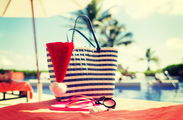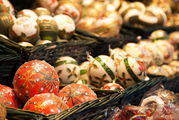In the coral jungle
 The coral sea, washing the northeast coast of Australia, got its name because of the abundance of coral reefs and islands. The Great Barrier Reef, stretching along the northeast coast of Australia for 2,000 kilometers, is the most unique coral formation in the world. The width of the reef in the northern part is on average two kilometers; to the south it increases, reaching 150 kilometers in places. The reef is separated from the mainland by a lagoon, the depth of which reaches 50 meters. The Great Barrier Reef is intersected by natural canals and ducts.
The coral sea, washing the northeast coast of Australia, got its name because of the abundance of coral reefs and islands. The Great Barrier Reef, stretching along the northeast coast of Australia for 2,000 kilometers, is the most unique coral formation in the world. The width of the reef in the northern part is on average two kilometers; to the south it increases, reaching 150 kilometers in places. The reef is separated from the mainland by a lagoon, the depth of which reaches 50 meters. The Great Barrier Reef is intersected by natural canals and ducts.
The opening of the underwater ridge
The future famous British navigator James Cook in her childhood shepherded cows, he studied at school for only three years, and at seventeen he moved to the coastal city of States. He did not become a fisherman, but went to the shop as a grocer. Once, during a storm, a shop was washed away into the sea, and from that day on, his whole subsequent life began to belong to this element.
Cook entered the naval service. He served as a sailor for only one month, then became a boatswain, assistant navigator, and finally brilliantly passed the navigational exam. It was then that he had a dream – to reduce white spots from a map of the Earth …
The first expedition of Cook was the discovery of the eastern coast of Australia – New South Wales.
A month and a half Cook without special incidents moved along the coast of New Zealand, further north, until he ran into a giant coral ridge. This seafaring hazardous strip of reefs and shoals separates the northeast coast of Australia from the Great Barrier Reef. Behind Cape Tribulation, or Cape of Adversity, as Cook called it, the ship hit a coral reef. With great difficulty, the ship was repaired, and it set off again, skillfully maneuvering among reefs and shallows.
Cook’s miraculously preserved diaries contain a record after the ship jumped onto the reef: “In these truly terrible minutes, everyone continued to do what was in their power, as calmly as ever. The dangers that we previously managed to avoid were insignificant before the threat of being thrown onto reefs, where in an instant nothing would have remained of the ship. ”
The team managed to slip through the reefs along the passage, which they called “Providence.” Having passed the strait separating Australia from New Guinea, Cook confirmed the very fact of its existence. In the Coral Sea, he studied and mapped the Great Barrier Reef.
The maelstrom of life
The reef resembles a half-submerged fortress wall consisting of almost 2,900 separate reefs and 71 islands. His age is ten thousand years. After all, the coral reef is a grandiose and complex structure in which the diversity of forms has truly reached its limit. This is a giant clot of life, in which hundreds of living organisms are represented.
You can watch corals for hours. This is where the maelstrom of life is, its unique diversity: from the smallest plants to huge giants-corals, sponges, turtles, starfish and hedgehogs, fish and worms. Bright spots of sponges are scattered on the limestone rocks, and massive claws of large crabs are visible in the recesses. Only under water can you really see the many-colored coral, which is not available in the dim copies of representatives of the underwater kingdom exhibited in museums.
Here is the serpentine coral of Colpophyllia natans. At first glance, it seems very difficult, but in fact, any baby can lift it. And nearby – the ocellarous corals of Montastrea cavemosa – real giants. Sometimes they reach one and a half meters in height. Keep away from fire coral Millepora complanata. Flat thin plates depart from its base, the touch of which is very painful. On the body there is a red burn mark from a small “harpoon” with which special stinging cells are fired. They serve to attack and defend. Each such cell contains a capsule in which there is an elastic, like an arrow, thread, seated with backward-facing spikes. It turns out a real harpoon. When irritated, the capsule “shoots” and the harpoon digs into the victim.
You can admire the rare color of the Great Barrier Reef for hours, which changes from the weather, the time of day, and maybe the mood.
Along the reef
Those who visit the Great Barrier Reef should wish to take a trip along the reef is a very exciting and informative activity. Around the blue, with shades of turquoise, the sea, a light breeze does not allow the sun to burn you. The brown Noldi – they are also called “silly terns” for some reason – will accompany you along the way, talking about something. A whole flock of dolphins can swim nearby for almost an hour. Some occasionally lie on their side, and, cunningly squinting their eyes, examine you. Others jump out of the water, grunting with pleasure. The water is so clear that you can see how the whole bottom is overgrown with real coral forest. There are large rounded masses of coral, mushroom-like, tree-like, branched, lamellar. And any artist will envy the color palette.
The main scourge of the Great Barrier Reef is pirate pirates. On the horizon, speedboats flicker on and off, which instantly turn to the side, seeing “alien” ships. These barbarians literally gnaw at the Great Barrier Reef, breaking off the most beautiful corals, after which they begin to die. The salvation of the Great Barrier Reef from destruction is a universal task.



